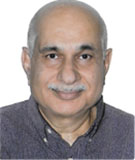Assoc Prof Sanjay Khanna
 Sanjay Khanna
Sanjay Khanna
Associate Professor, Department of Physiology
Yong Loo Lin School of Medicine
Tel: 6516 3665
Email: phsks@nus.edu.sg
What are your present research interests or distinctive viewpoint to your research?
The laboratory has pioneered investigations into the role of medial septum in chronic pain. Our postulate is that the medial septum is a nodal region that modulates network mechanisms in the CNS which underpin the altered perception (i.e. hypersensitivity) and co-morbid affective and cognitive dysfunctions in chronic pain conditions. The laboratory is particularly strong in system neurobiology and using techniques for system analysis, such as in vivo electrophysiology, behavior and optogenetics, we have begun to identify neural and neurochemical basis of the role of medial septum in experimental chronic pain.
What do you see as your future research directions?
In particular, we are investigating the neural plasticity induced in pain and on medial septum manipulation. In context of foregoing, we have observed, for example, that non-cholinergic, especially GABAergic neurons in the region modulate pain-induced aversion suggesting that these neurons have a potential to play a crucial role in sustaining the aversive-fearful state of chronic pain. The effect of GABAergic neurons was related to modulation of cell signalling and translation in cortical regions. However, interestingly, the GABAergic neurons do not influence acute pain behaviors suggesting that that distinct neural mechanisms in the septal region sub-serve different aspects of pain.
Does your laboratory have a particularly strong research expertise?
The laboratory is also closely aligned with other pre-clinical and clinical investigators in collaboration with whom we plan to work on neural and neurochemical leads identified in the laboratory for the purpose of drug discovery and technology based management of clinical chronic pain.
Recent Publications
1. Ang, ST., Ariffin, MZ and Khanna, S. The forebrain medial septal region and nociception. Neurobiology of Learning and Memory. Neurobiology of Learning and Memory 138: 238–251, 2017
2. Ariffin, MZ., Low, CM. and Khanna, S. Medial septum modulates cellular response induced in hippocampus on microinjection of cholinergic agonists into hypothalamic lateral supramammillary nucleus. Frontiers in Neuroanatomy 11: 79, 15 September 2017; 10.3389/fnana.2017.00079.
3. Teh, DBL., Prasad, A., Jiang, W., Ariffin, MZ., Khanna, S., Belorkar, A., Wong, L., Liu, X. and All, AH. Transcriptome Analysis Reveals Neuroprotective aspects of Human Reactive Astrocytes induced by Interleukin 1 beta. Scientific Reports 10.1038/s41598-017-13174-w.
4. Ariffin MZ., Ibrahim KM., Lee AT-H., Lee RZ, Poon SY., Thong HK., Liu EHC., Low C-M. and Khanna S. Forebrain medial septum sustains experimental neuropathic pain. Scientific Reports 8: 11892, 08 Aug 2018.
5. Liu C., Zhang CW., Lo SQ., Ang ST., Chew KCM., Yu D., Chai BH., Tan B., Tsang F., Tai YK., Tan BWQ., Liang MC., Tan HT., Tang JY., Lai MKP., Chua JJE., Chung MCM5., Khanna S., Lim KL. and Soong TW. S-Nitrosylation of Divalent Metal Transporter 1 Enhances Iron Uptake to Mediate Loss of Dopaminergic Neurons and Motoric Deficit. Journal of Neuroscience 38(39): 8364-8377, 26 Sep 2018.

